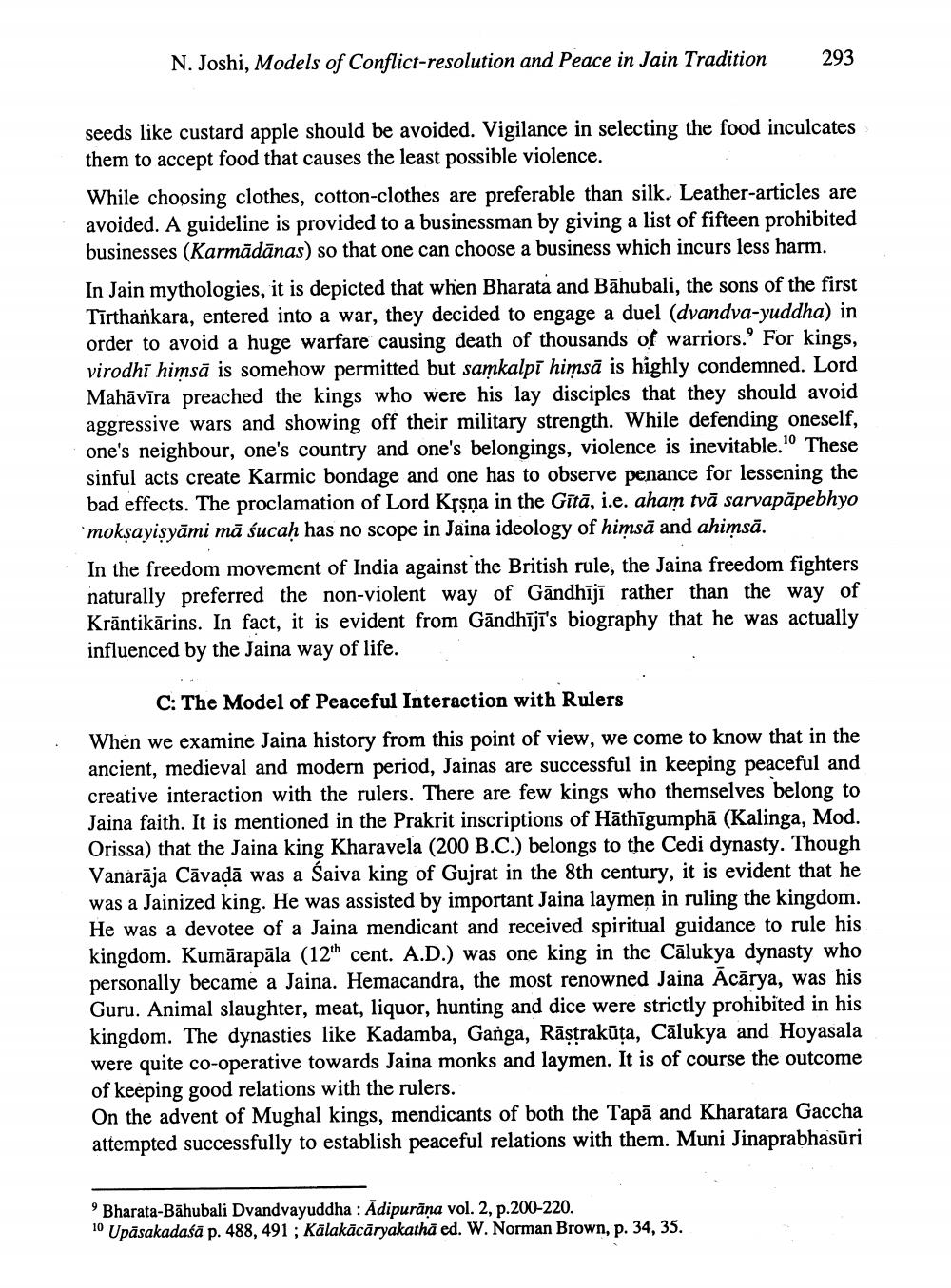________________
N. Joshi, Models of Conflict-resolution and Peace in Jain Tradition
293
seeds like custard apple should be avoided. Vigilance in selecting the food inculcates them to accept food that causes the least possible violence.
While choosing clothes, cotton-clothes are preferable than silk. Leather-articles are avoided. A guideline is provided to a businessman by giving a list of fifteen prohibited businesses (Karmādānas) so that one can choose a business which incurs less harm. In Jain mythologies, it is depicted that when Bharata and Bāhubali, the sons of the first Tīrthankara, entered into a war, they decided to engage a duel (dvandva-yuddha) in order to avoid a huge warfare causing death of thousands of warriors. For kings, virodhi himsā is somehow permitted but samkalpi himsā is highly condemned. Lord Mahāvīra preached the kings who were his lay disciples that they should avoid aggressive wars and showing off their military strength. While defending oneself, one's neighbour, one's country and one's belongings, violence is inevitable. These sinful acts create Karmic bondage and one has to observe penance for lessening the bad effects. The proclamation of Lord Kșsna in the Gītā, i.e. aham tvā sarvapāpebhyo 'mokşayisyāmi mā śucah has no scope in Jaina ideology of himsā and ahimsā. In the freedom movement of India against the British rule, the Jaina freedom fighters naturally preferred the non-violent way of Gāndhījī rather than the way of Krāntikārins. In fact, it is evident from Gāndhījī's biography that he was actually influenced by the Jaina way of life.
C: The Model of Peaceful Interaction with Rulers When we examine Jaina history from this point of view, we come to know that in the ancient, medieval and modern period, Jainas are successful in keeping peaceful and creative interaction with the rulers. There are few kings who themselves belong to Jaina faith. It is mentioned in the Prakrit inscriptions of Hāthīgumphā (Kalinga, Mod. Orissa) that the Jaina king Kharavela (200 B.C.) belongs to the Cedi dynasty. Though Vanarāja Cāvadā was a Saiva king of Gujrat in the 8th century, it is evident that he was a Jainized king. He was assisted by important Jaina laymen in ruling the kingdom. He was a devotee of a Jaina mendicant and received spiritual guidance to rule his kingdom. Kumārapāla (12ch cent. A.D.) was one king in the Cālukya dynasty who personally became a Jaina. Hemacandra, the most renowned Jaina Ācārya, was his Guru. Animal slaughter, meat, liquor, hunting and dice were strictly prohibited in his kingdom. The dynasties like Kadamba, Ganga, Rāstrakūta, Cālukya and Hoyasala were quite co-operative towards Jaina monks and laymen. It is of course the outcome of keeping good relations with the rulers. On the advent of Mughal kings, mendicants of both the Tapā and Kharatara Gaccha attempted successfully to establish peaceful relations with them. Muni Jinaprabhasūri
Bharata-Bāhubali Dvandvayuddha : Adipurāna vol. 2, p.200-220. 10 Upāsakadaśā p. 488, 491; Kālakācāryakathā ed. W. Norman Brown, p. 34, 35.




